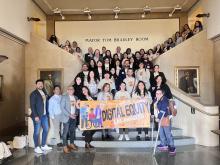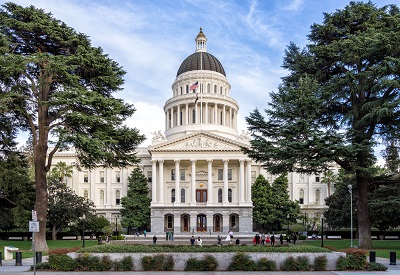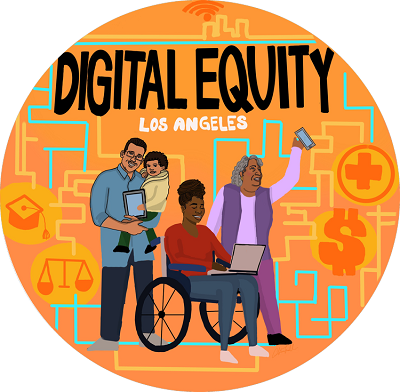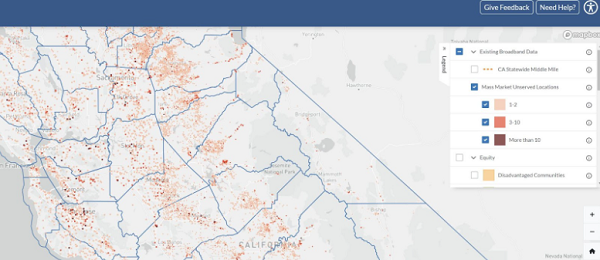
Fast, affordable Internet access for all.

As California aims to boost broadband competition and Los Angeles County pursues what could be the biggest municipal broadband network ever built, local activists say they’ve made some meaningful recent inroads on both improving broadband mapping, and regulatory reform that should aid the equitable deployment of modern, affordable access.
Recently, inroads have been made on fixing long-broken California cable franchise law. In the early aughts, cablecos (and telcos pushing into the TV business) successfully lobbied for state-level “cable franchise reform” laws they promised would dramatically lower prices. In reality, such bills were often little more than legislative wishlists crafted by telecom giants.
Often these state-level replacements for local franchise agreements eroded legal regulatory authority, eliminated long standing requirements for uniform broadband and TV deployment, and in some states–like Wisconsin–even acted to strip away local consumer protections and eminent domain rights. Warnings by academics on this front were widely ignored.
Seventeen years after its passage, California activists say that California’s 2006 Digital Infrastructure and Video Competition Act (DIVCA) was no exception.

As in other states, DIVCA supporters vilified local franchises as cumbersome constructs that harmed broadband and cable TV deployment, promising that a state-level replacement would result in more uniform access, robust competition, and lower prices for telecom, video, and voice services. In the majority of states that utopian vision never materialized.
California consumer advocates have long noted that DIVCA had no equal access requirement and outdated anti-discrimination provisions, making it easy for regional monopolies to ignore marginalized communities when it came time for next-generation broadband upgrades.
DIVCA failed to grant the California Public Utilities Commission (CPUC) authority to establish service quality requirements, or a mechanism allowing consumers to complain about substandard access. And it granted 10 year state-level franchise agreements that are easily renewed with no meaningful public input.
Enter the Digital Equity in Video Franchising Act of 2023 (DEVFA), a bill proposed by California District 41 Assembly member Chris Holden. The bill recently passed out of the Assembly Communications and Conveyance Committee, and aims to shore up all of DIVCA’s oversights—particularly as it pertains to equitable broadband deployments.
“DIVCA has fallen short of all three of its principal goals,” the California Community Foundation (CCF) noted in a fact sheet on the proposed reform. “There is less competition than there was a decade ago, prices have remained steady or increased, and hundreds of thousands of Californians remain stranded on the wrong side of the digital divide.”
That was made particularly clear during Covid school lockdowns, when children in Salinas were forced to huddle in the dirt outside of fast food restaurants simply to obtain access to broadband for their education.
According to the CPUC, 97.7 percent of California’s broadband connections come via cable giants like Comcast (Xfinity) or Charter (Spectrum), who enjoy regional monopolies in most California markets. That lack of competition routinely results in spotty access, high prices, slower speeds, and some of the worst customer satisfaction ratings of any industry in America.
What that means in practical reality for historically-marginalized groups was highlighted in a study published in October by a coalition of organizations advocating for community-based action to close the digital divide known as Digital Equity LA. The study detailed how economically vulnerable households in LA County pay more for slower Internet service than those in wealthy neighborhoods – a reality some state lawmakers are now looking to address.
“DIVCA’s outdated anti-discrimination statutes and a lack of focus around digital equity issues generates little incentive for providers to give equal service to low-income and unserved areas,” Howell’s office said in a statement. “AB 41 aligns the CPUC’s authority with federal law, creates a robust application and renewal process for ten-year state video franchises, grants the Commission authority to regulate terms and conditions, and allows the Commission to establish service quality requirements and a mechanism for customer complaints.”
California Activists Also See Promising Traction On Mapping Reform
Like most of America, California has also struggled to accurately map broadband access. That’s generally thanks to shoddy mapping by the FCC, which has now spent more than $400 million on broadband maps consumer groups say still don’t accurately reflect reality. While recent updates are an improvement, many still say the maps fall well short of their goal.
These substandard FCC broadband maps inform state maps, often making it easy for telecom giants to disguise market failure, obfuscate limited competition, and downplay the real impact of monopolization and digital redlining, or what the FCC refers to as “digital discrimination.” With billions in Covid and infrastructure bill funding headed to the states, the problem has seen significantly more attention than ever before.

In California, a coalition of organizations like Digital Equity LA have been applying pressure on the CPUC to develop maps that better reflect reality, limited competition, and the impact that antiquated or unreliable networks routinely have on long-marginalized communities.
Digital Equity LA members have been noting for years how definitions of “served” or “unserved” as it pertains to broadband access are often dictated by powerful local monopolies keen on downplaying the dynamics that sustain a massive digital divide.
“The CPUC’s map relied on an analysis documenting where networks could be most profitable–without any reference to equity–resulting in the Commission releasing a ‘priority areas map’ that prioritized for public broadband subsidies many of the state’s wealthiest, best connected communities and none of the most disadvantaged neighborhoods in any urban core,” the group said.
Disproving the false picture painted by entrenched monopolies usually falls to underfunded state broadband offices and local activists, going toe to toe with well-funded telecom monopolies looking to downplay limited competition and longstanding service gaps.
This month those groups say they saw notable progress thanks to a new CPUC Federal Funding Account Public Map that more realistically reflects affordability and the under-delivery of an essential utility to marginalized neighborhoods.
It also more transparently indicates where billions in state and federal resources are actually being allocated.

“Thanks to coordinated collective action, we won a huge victory last month, and saw it come to fruition with a newly released set of maps from the California Public Utilities Commission that both center equity and better reflect what we know to be true on the ground,” Digital Equity LA said in a statement.
Some federal agencies like the National Telecommunications and Information Administration (NTIA) have also taken recent criticism to heart, and have increasingly integrated additional data sets to inform newer maps more focused on affordability, which data indicates remains one of the biggest barriers to broadband access.
The CPUC’s mapping improvement efforts on this front are part of California’s massive $7 billion broadband expansion plan, $3.25 billion of which will go toward constructing a statewide middle-mile, open access fiber network with an eye on boosting competition and driving down consumer costs.
Header image courtesy of Digital Equity LA
Inline image of California statehouse in Sacramento courtesy of Wikimedia Commons, Attribution-ShareAlike 3.0 Unported (CC BY-SA 3.0)
